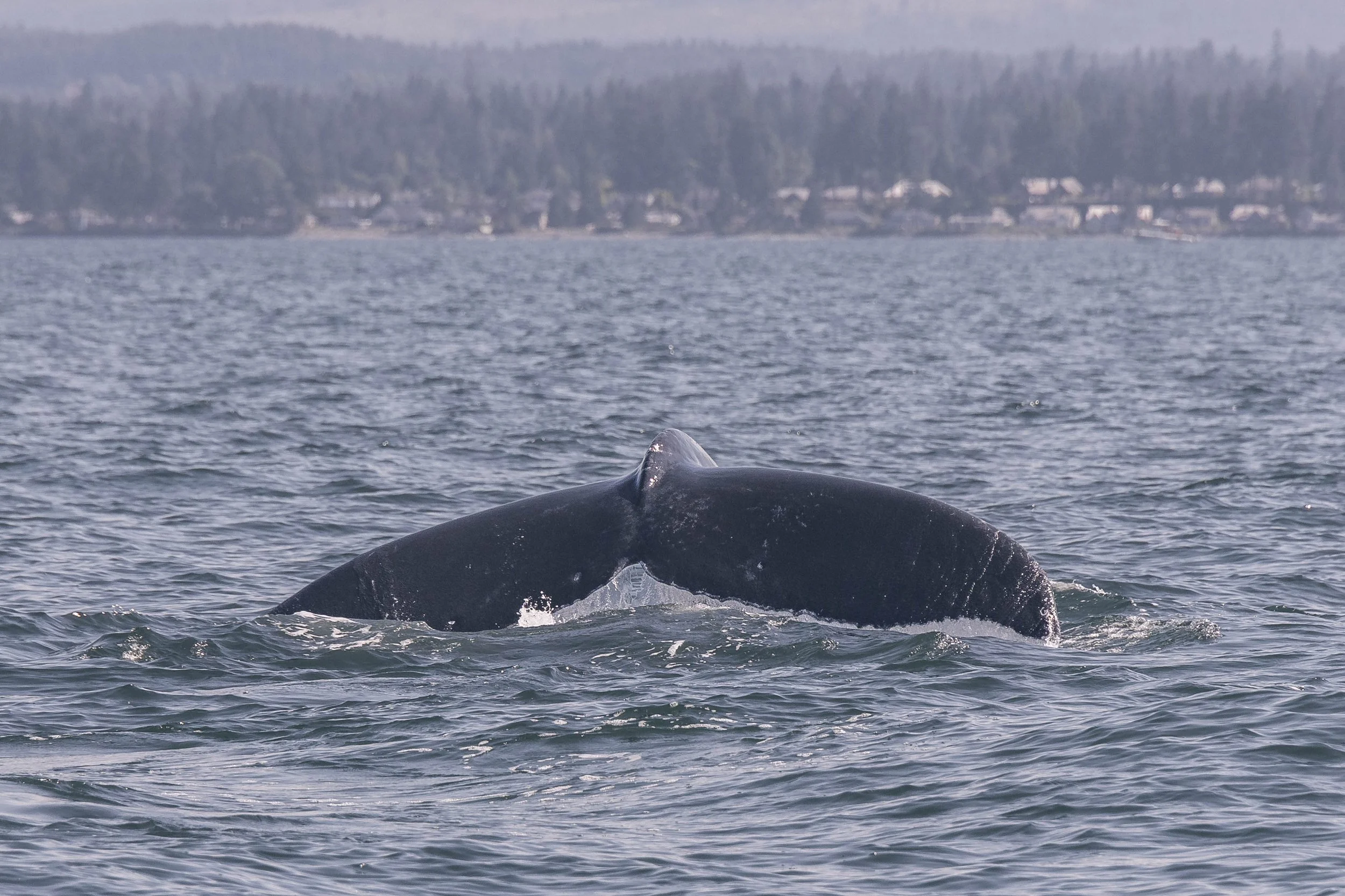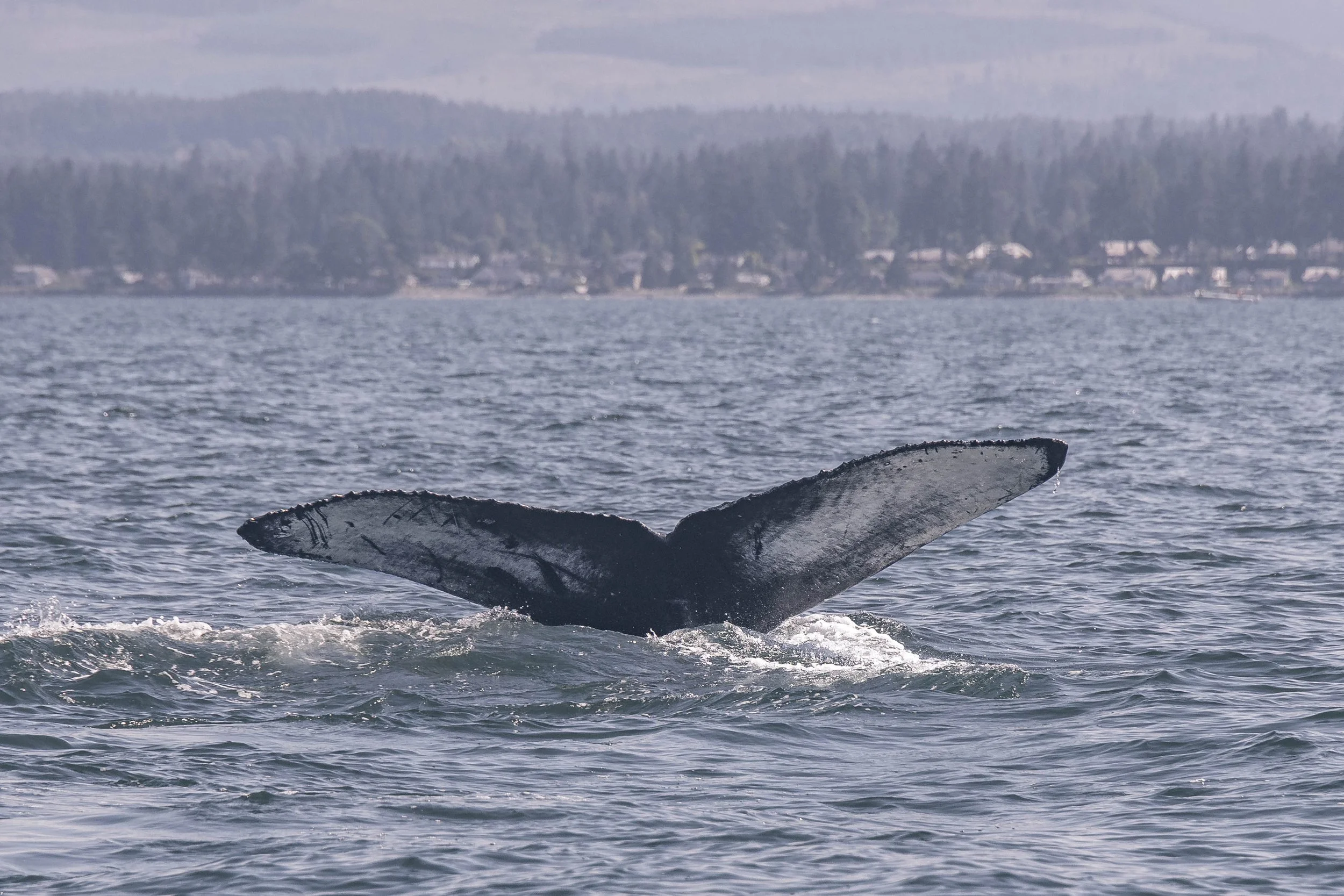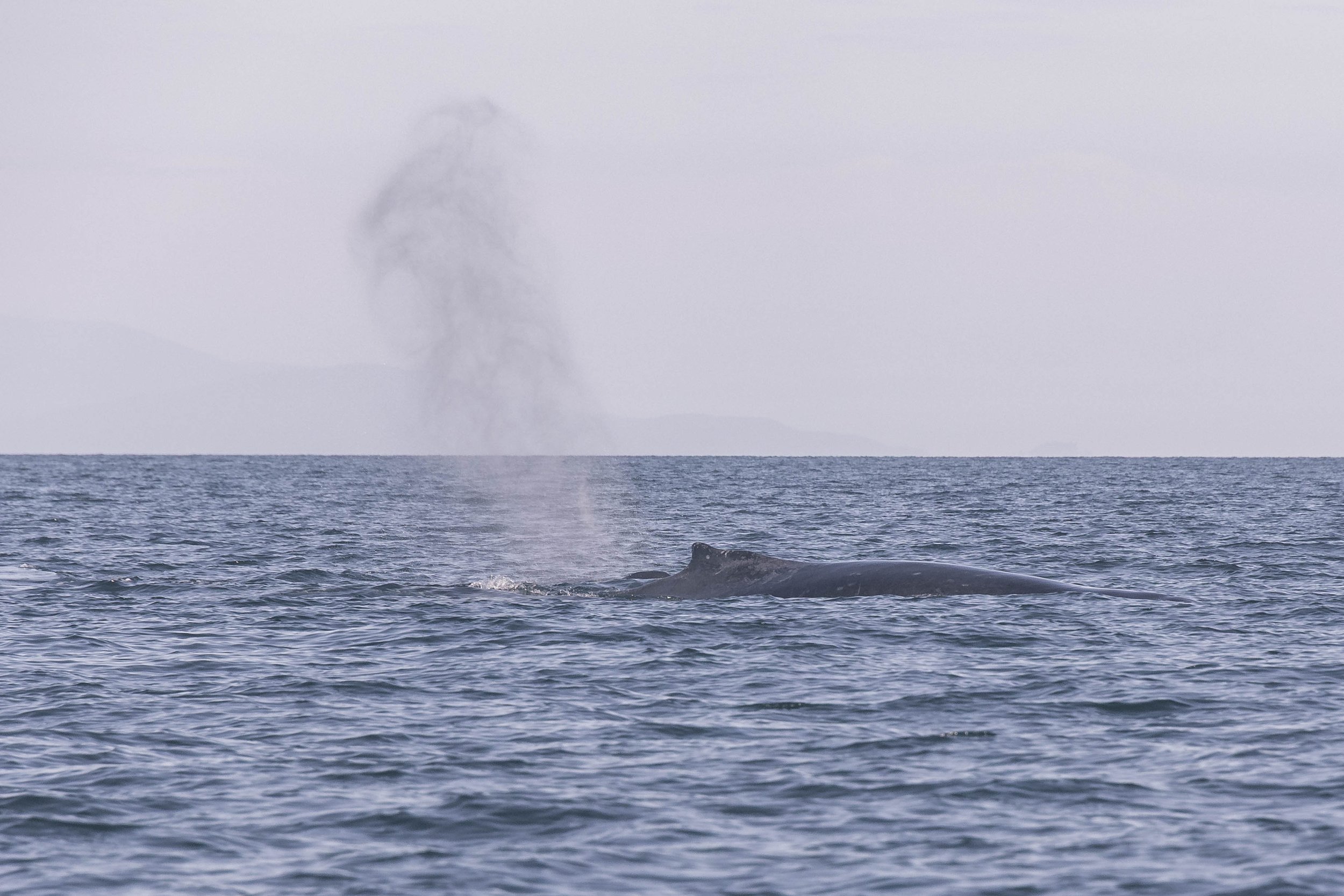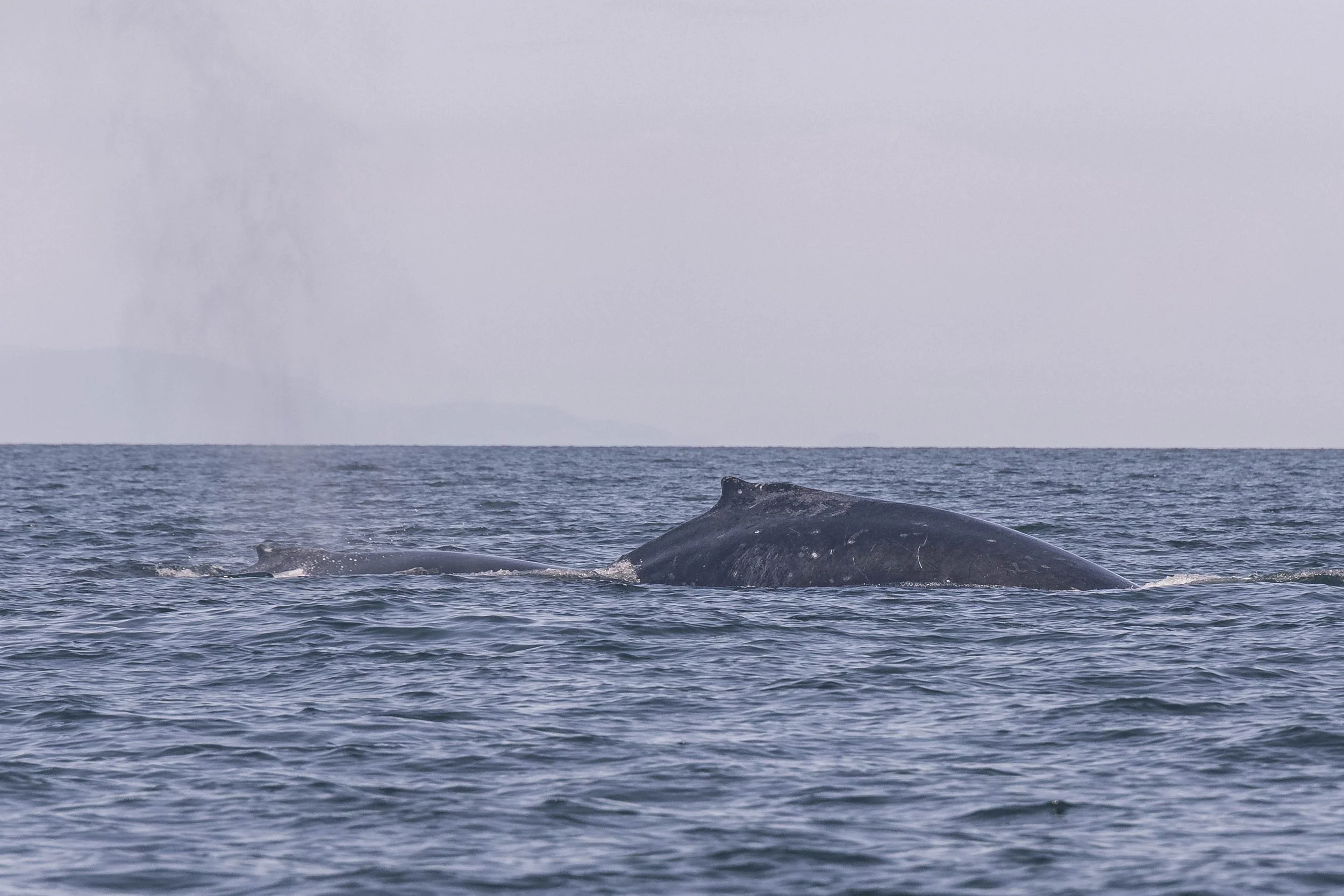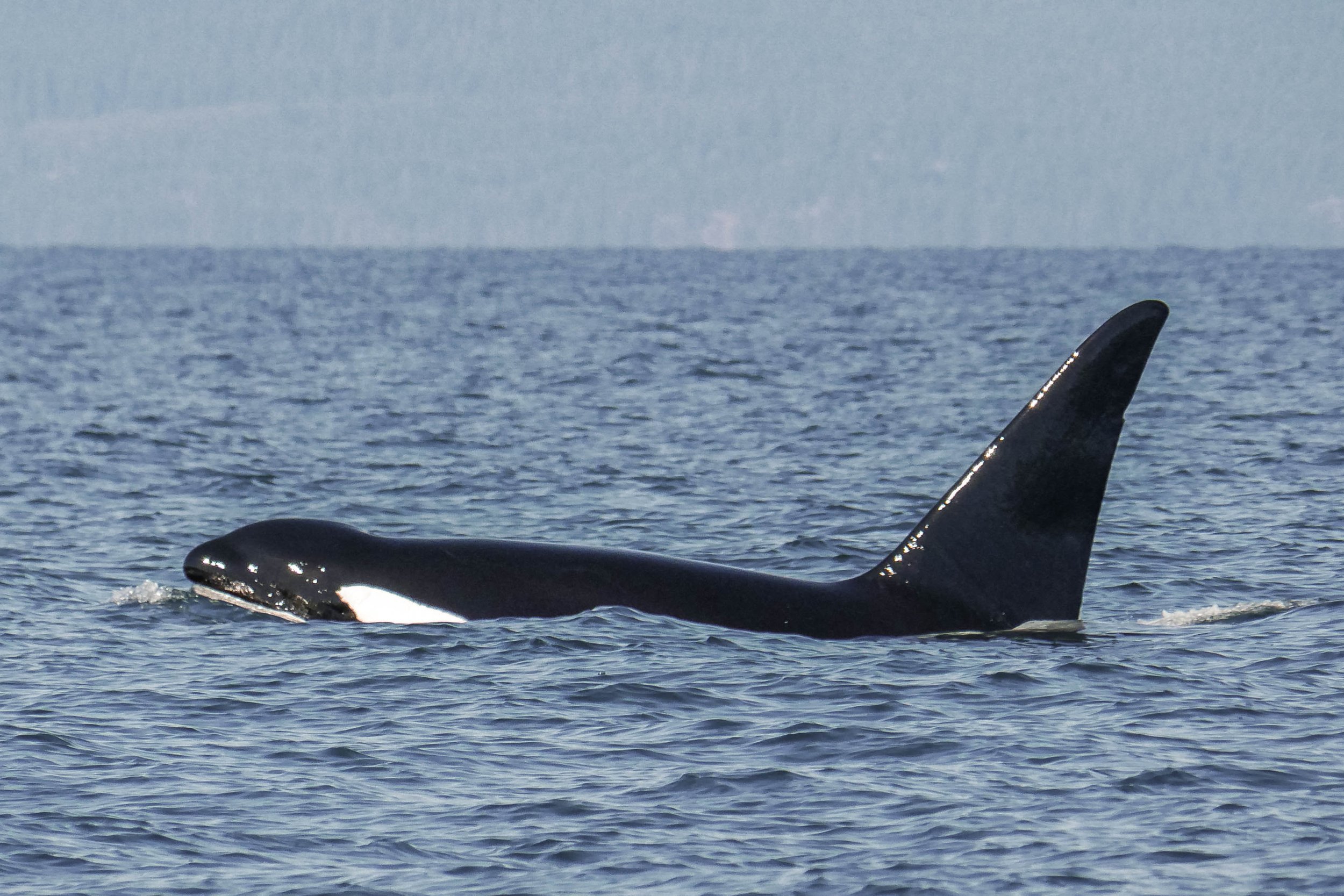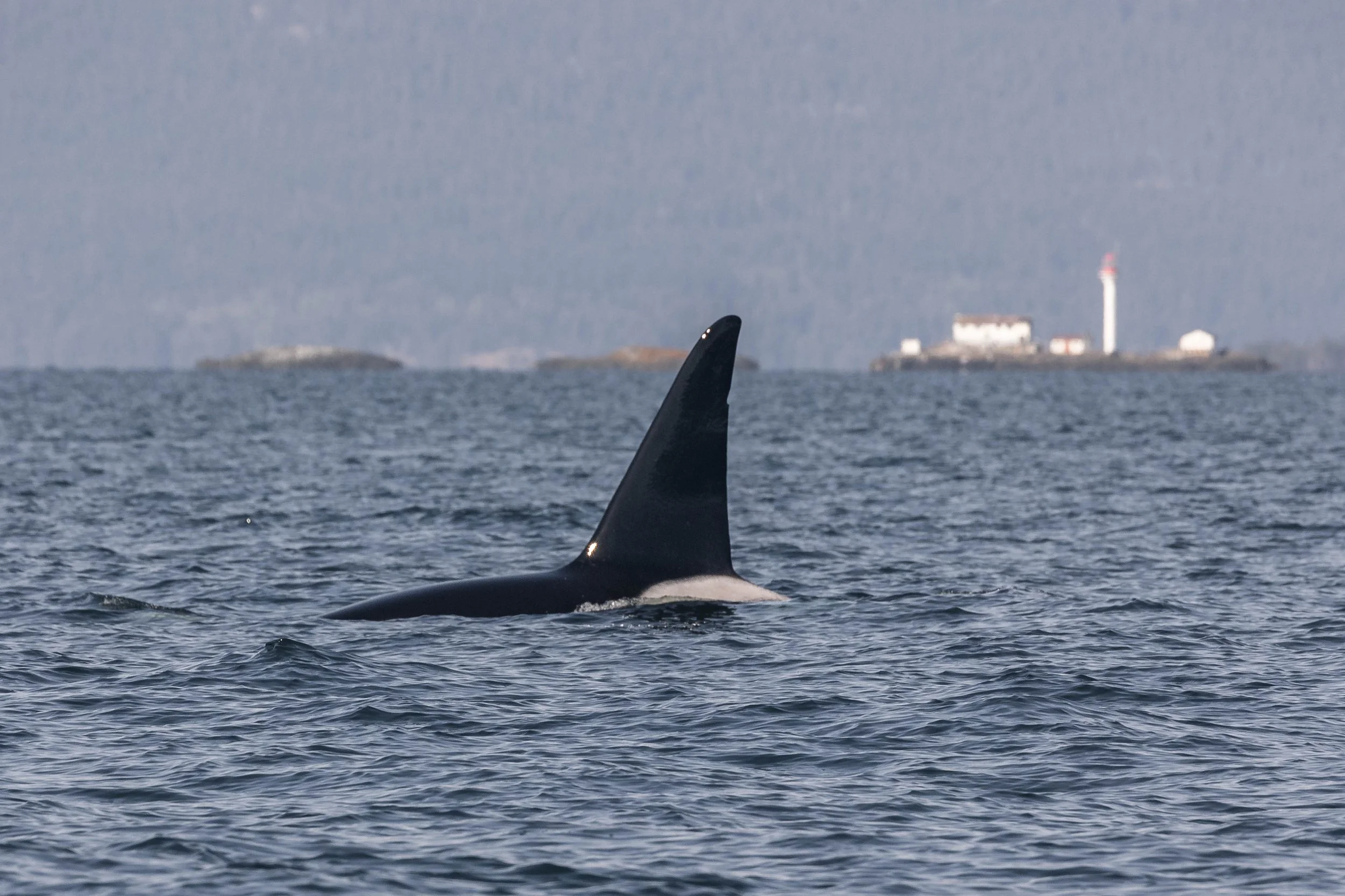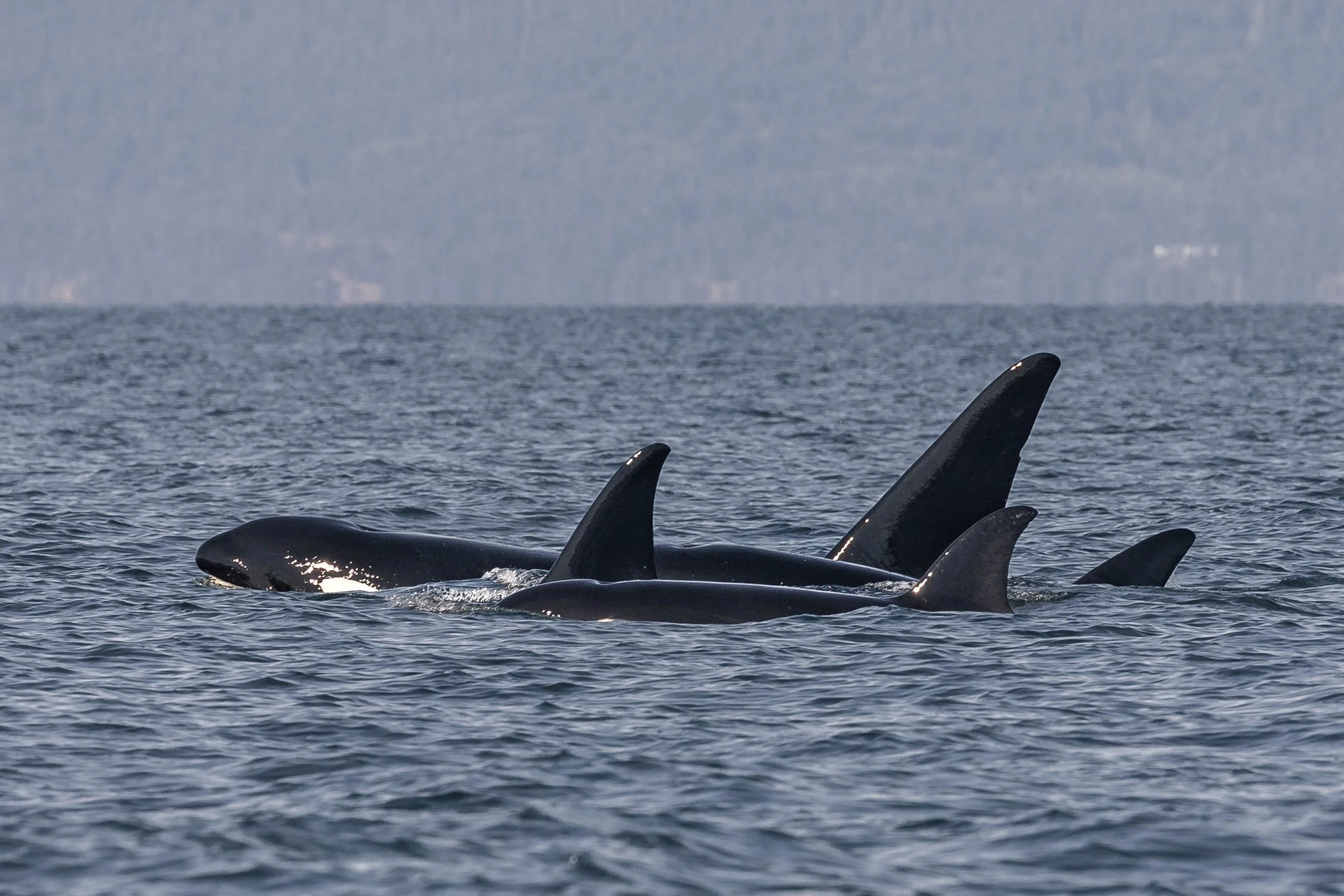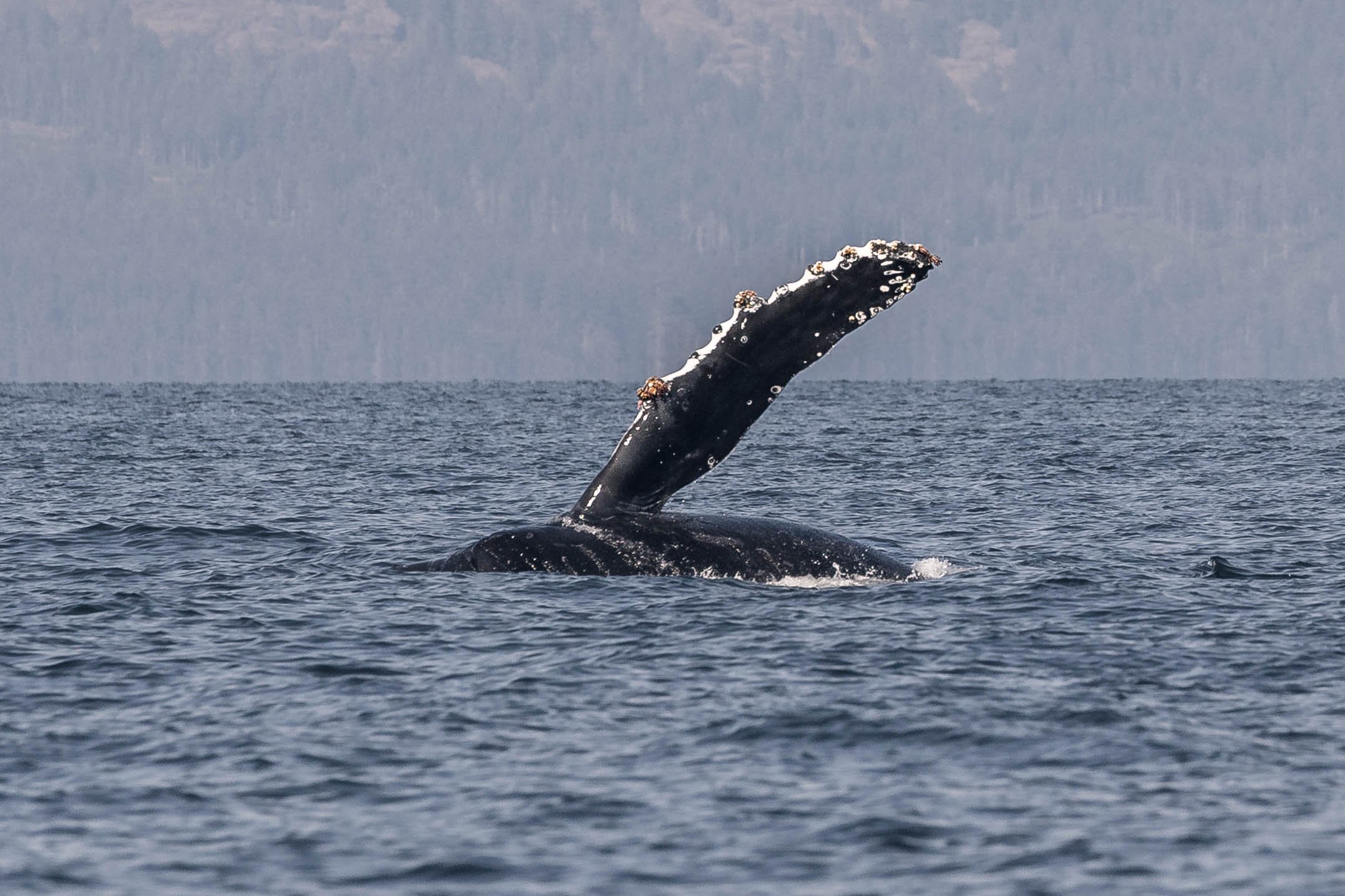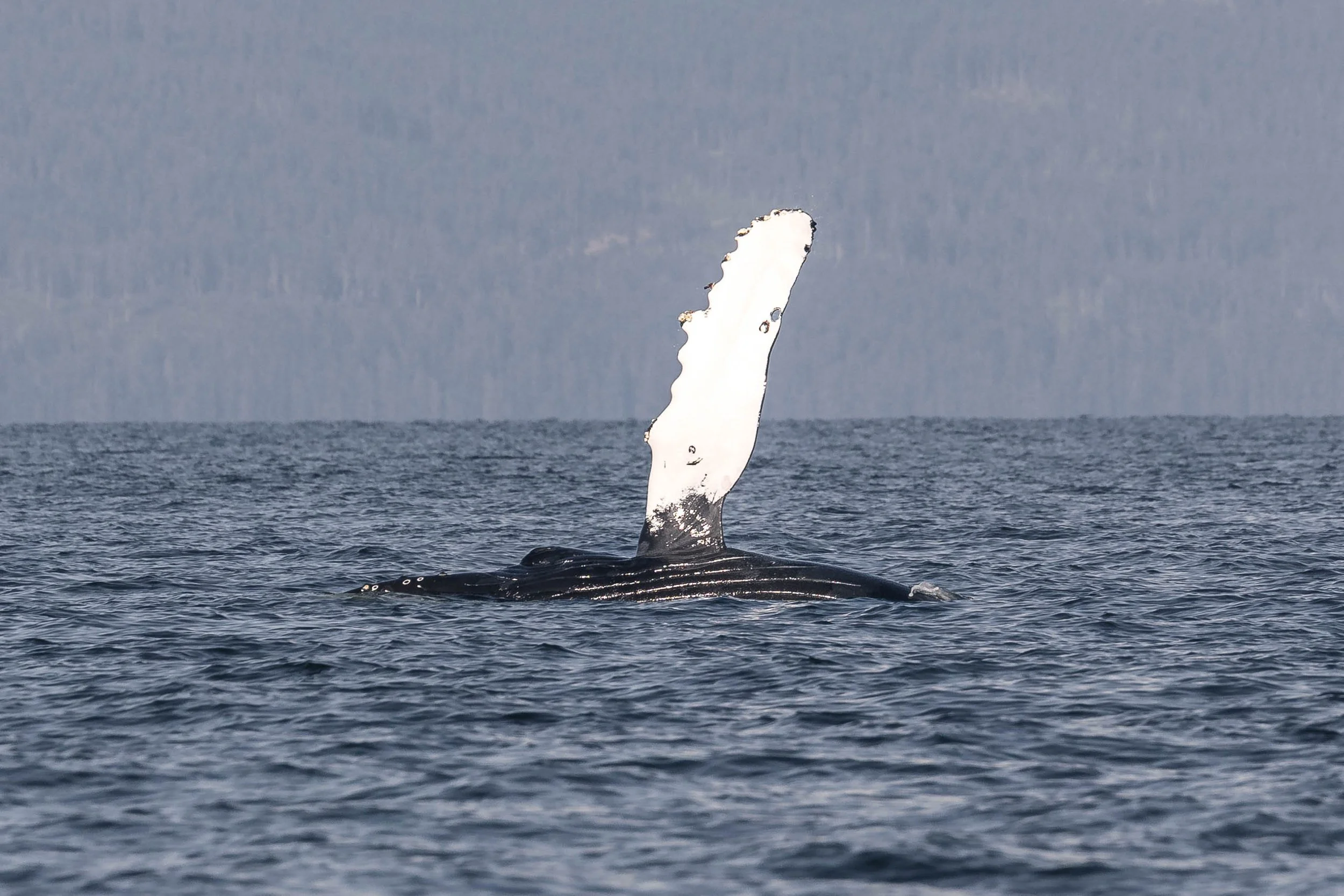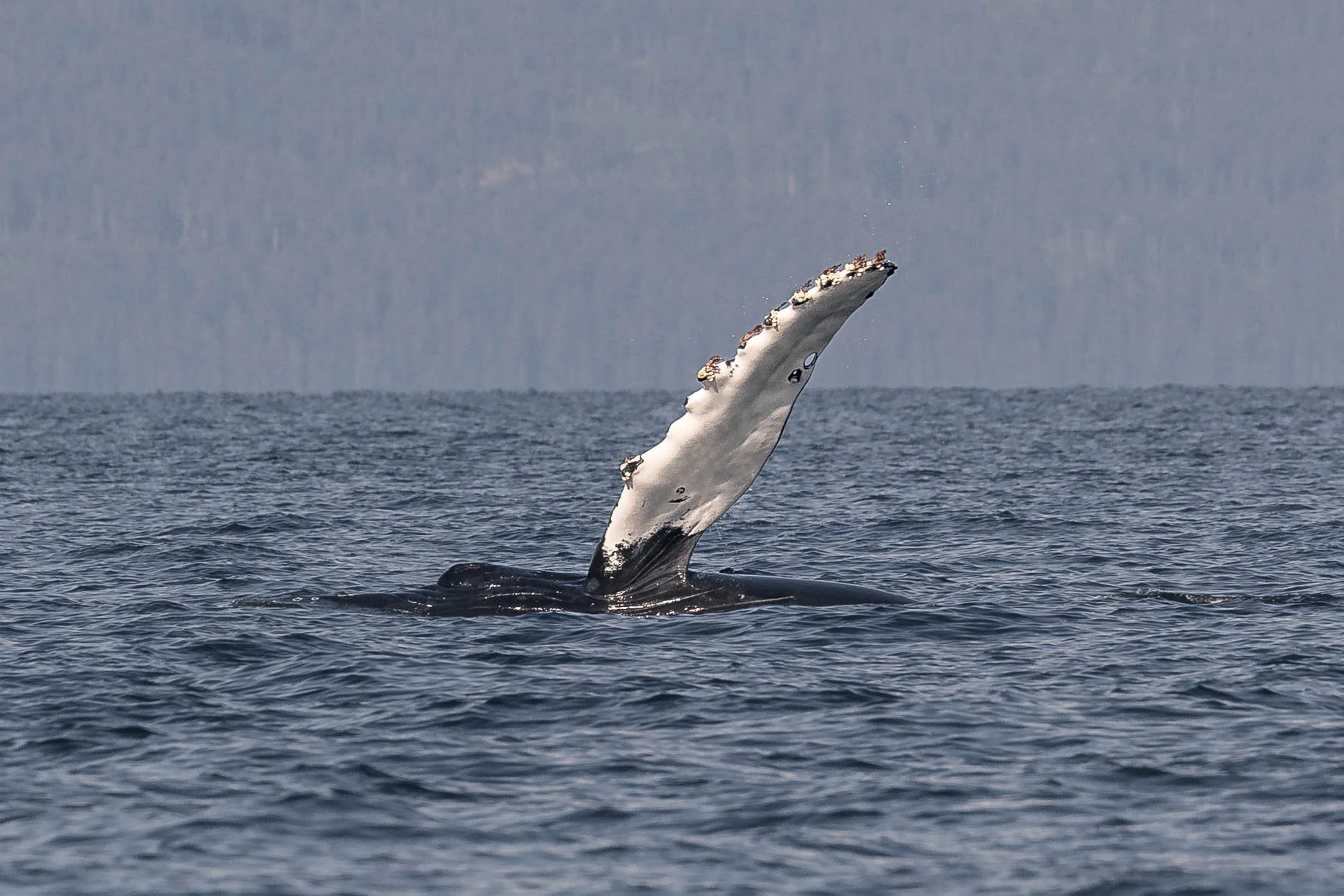July 20, 2025, 3:30 PM - Northbound: Double Species Feature
After a very successful morning trip, we were excited to head out and have an equally successful afternoon trip! We began our search northbound, in the direction where our orca were last seen travelling. It had been multiple hours since a confirmed sighting, so we were extra diligent in scanning as we cruised along. With no trackers or tags on them, we never know where they will show up from trip to trip!
Our fleet spread out, a tactic used to increase our sightlines as much as possible. After spreading out, our semi-covered vessel Kula spotted a pair of humpbacks along the way! Our other vessels continued onwards, hopes still high in relocating the orca. Kula stayed with the humpback duo briefly to try and get ID shots of them as they travelled along and fluked (raised their tails out of the water). We usually use the underside of their tails to identify them, as that pattern is as unique to a humpback as a fingerprint is to us. However, these two were a bit of a different case. One of the Unknowns we got a perfect, catalogue-worthy shot from their fluke… but we were unable to crossmatch them! This particular Unknown we have had a couple of times this year, and somehow, we still aren’t sure who they are. They are likely a younger whale who may not have fluked in previous encounters, as this is common for calves in their first year of life. Calves also tend to have pigment changes as they begin to age, leading to fading (or sometimes increases!) in the white pigmentation on their tail, resulting in changes to their patterns. Entanglements may also lead to scratches, nicks, notches, or large chunks missing from their flukes, which can also change their flukes’ appearances. Our Known Unknown’s friend was being a bit less cooperative, though, as we were only able to get a dorsal photo from them. Sometimes we can ID humpbacks from this, but this little one still remains a mystery as well. Shortly after we said goodbye to our mystery whales, Kula headed out to continue the search for orca!
Our fleet searched and searched until our open vessel, Cascadia, spotted them! 4 sleek bodies slicing through the waters, with one huge dorsal fin towering over the others. This was the T123s, the pod that had been down by Nanaimo earlier today:
T123 Sidney ♀ (~1985)
T123A Stanley ♂ (2000)
T123C Lucky ♀ (2012)
T123D Darcy ♀ (2018)
At this point, they had swum roughly 50 km since we last saw them, and they didn’t seem to be slowing down! The family was continuing their northward trek as we watched them, pointing towards Hornby Island. They were displaying very typical orca behaviour, just simply travelling along. When we first encountered them, they were very spread out; however, they came together and travelled as a family unit shortly after. They could have been scouting the area, searching for an easy bite to eat. Transient orca hunt similarly to wolves, where they will go after one individual all together. Spreading out is a tactic to increase their search area for prey, similarly to how our fleet spread out earlier today to find these whales! Once they were back together, the pod members were travelling tightly side-to-side, socializing and enjoying each other’s company.
We left the T123s to continue their travels and entered back into search mode. We didn’t have to look for long, though, as suddenly there was a huge splash off to the side. We made our way over to where a very splash-happy humpback was slapping their tail at the surface of the water over and over and over! Thanks to these splashes, we were quickly able to get an ID shot, and we confirmed that this was KEX0082, a relatively new whale to the area with no nickname at this time. KEX0082 continued slapping and slapping… and then suddenly, they changed it up! They began rolling around, pectoral slapping (slapping their massive side fins on the surface), causing loud thumps to ring out into the air. After that, they did what many consider the ultimate humpback behaviour: they dove down and then breached high into the air, clearing most of their body from the water, and landing with a loud ‘thump’ back down to the surface. They didn’t do this just once, though - they did it repeatedly, popping up into the air over and over! Breaching consumes a tremendous amount of calories, and to do it so frequently back-to-back suggests this whale must be feeding extremely well. In our waters, humpback diets are largely made up of krill, with occasional feasts of small schooling fish such as sandlance, anchovies, or potentially juvenile salmon as well. Consuming thousands of pounds of tiny animals can be very time-consuming, though, so these gentle giants will spend many hours of the day foraging away to fill their bellies. While scientists are not sure why these impressive whales breach, it is always absolutely incredible to witness, and we were in awe watching KEX0082 take to the skies.
As the sun was beginning to set, we had to leave our jumping whale behind and start making our way back south towards Nanaimo. We did have to make a little stop, though, as we wanted to try and find some other wildlife to visit. Our boats travelled to slightly different spots, but they had equal success finding Harbour Seals soaking up the sunset’s rays! These robust pinnipeds love to haul out on the flat, rocky islets that are scattered along our coastline. They live a very sedentary lifestyle, spending most of their day snoozing. One of these haulouts also had several Gulls wandering the shoreline, and a pair of Brant Geese - an uncommonly sighted bird species on our trips!
After seeing our seals, we continued onward, making the journey home. We headed back into the dock, wrapping up an amazing day exploring the northern waters of our region!
Please enjoy these photos taken by Marine Naturalists Desarae Poier, Jordan Robinson, and Hayleigh Hilbert!
Preparing for a dive. Photo by Hayleigh Hilbert.
One of our Unknowns - we have seen them a couple times this year, and still haven’t had any luck crossmatching them! Photo by Hayleigh Hilbert.
Our Unknowns travelling side by side. Photo by Hayleigh Hilbert.
One of the Unknowns appeared quite small compared to the other. Photo by Hayleigh Hilbert.
One of the Unknowns diving. Photo by Hayleigh Hilbert.
Unknown’s dorsal fin. Photo by Hayleigh Hilbert.
T123A Stanley. Photo by Jordan Robinson.
T123A Stanley. Photo by Jordan Robinson.
T123 Sidney (back), T123D Darcy, and T123A Stanley. Photo by Jordan Robinson.
T123A Stanley with the Sister Islands behind him. Photo by Des Poier.
T123A Stanley, T123 Sidney behind him, and T123D Darcy beside them. Photo by Des Poier.
The whole family! T123 Sidney in the middle, with her son T123A Stanley on her right, her daughter T123D Darcy on her left, and her other daughter T123C Lucky behind her. Photo by Des Poier.
T123A Stanley with his youngest sister T123D Darcy beside him. Photo by Des Poier.
KEX0082 was very excited today! Photo by Des Poier.
Waving their flukes around. Photo by Des Poier.
What a powerful splash! Photo by Des Poier.
KEX0082 has some very interesting and unique wrinkles radiating near the centre of their fluke. Photo by Des Poier.
A beautiful waterfall after a dramatic tail slap. Photo by Des Poier.
Look at all those unique dots, scratches, and notches! Photo by Des Poier.
KEX0082 launching into the air. Photo by Des Poier.
KEX0082 was regularly breaching today! Photo by Des Poier.
Look at all those barnacles! Photo by Des Poier.
Waving their pec fin around. Photo by Des Poier.
There is a large hole in this pec, which we could use to confirm their ID in the future if we come across them pec slapping again. Photo by Des Poier.
This whale’s pec was so white! Photo by Des Poier.
Breach for the sky! Photo by Des Poier.
What a landing! Photo by Jordan Robinson.
A little blep from a Harbour Seal! Photo by Des Poier.
Sleeping in the setting sun. Photo by Des Poier.
A cuddle puddle of Harbour Seals. Photo by Des Poier.
A pair of Brant Geese amongst the Gulls - a rare sighting on our tours! Photo by Des Poier.

